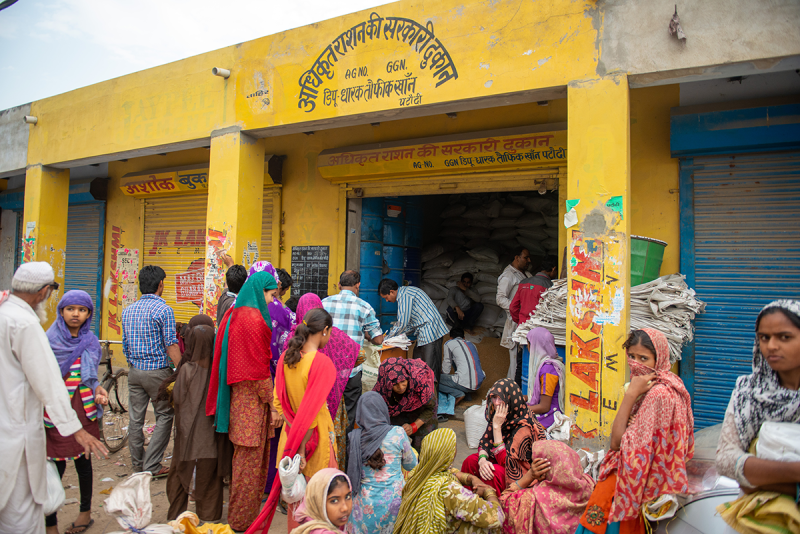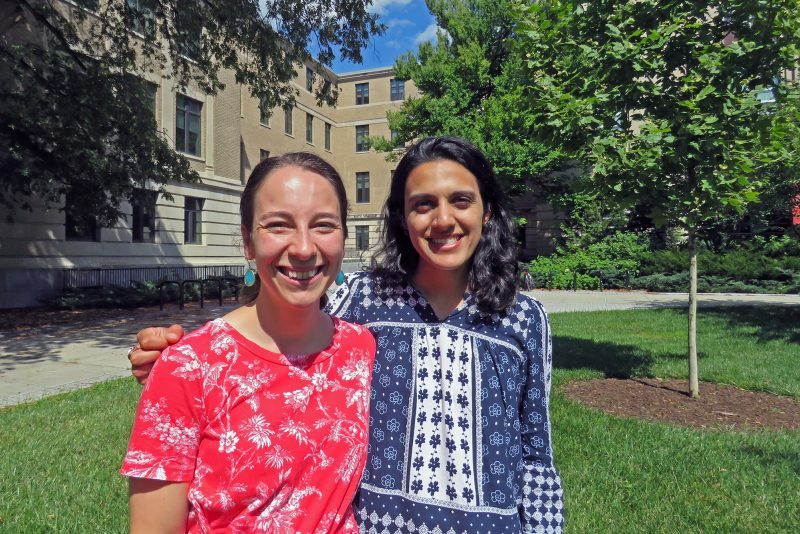Exploring the Markers of Differential Access to PDS
For the public distribution system in India, there are differential pathways of access as well as differences in quantities and prices, and quality of grains and services. This commentary, by Mamata Pradhan and Devesh Roy, appears in Economic and Political Weekly in EPW Vol. 54, Issue No. 26-27, on 29 June 2019.
Read the full text below.
Exploring the Markers of Differential Access to PDS
COMMENTARY JUNE 29, 2019 | Vol 54, Nos 26 & 27| EPW Economic & Political Weekly
By Mamata Pradhan, Devesh Roy
Mamata Pradhan (mp2226@cornell.edu) is with the Tata-Cornell Institute, Cornell University. Devesh Roy (d.roy@cgiar.org) is with the International Food Policy Research Institute, Washington, DC.
The various pathways of differential access to the public distribution system in India are analysed. There are three salient features of this exercise: the use of heterogeneous class, caste and gender positioning of the beneficiaries for understanding their varying ability to access their rights; the concept of “effective prices” as a determinant of differential access; and the quality of grains and services as a marker of subtler differentiation.
India allocates a substantial portion of the domestic budgets (approximately `2,03,243 crore as per the Budget Estimate-2018) to social safety net programmes where food-based programmes cost between 1% and 2% of the country’s gross domestic product (GDP) (Bhattacharya et al 2017). In the context of food-based safety net programmes, the public distribution system (PDS) is held as the nucleus of food security. Yet, it faces problems of weak institutions, elite capture, rent seeking and ineffi – cient technologies that impinge on access to food (Dutta and Ramaswami (2001; Saxena 2009; Svedberg 2012)
In this context, it is worth mentioning that the access to PDS (including issues such as whether, how and when to access), inter alia, is a function of different socio-economic factors such as purchasing power, social status, gender and social identity. The relationship of access with this complex web of social and institutional contexts potentially leads to heterogeneous situation for the beneficiaries. Heterogeneity, in turn, bears on how beneficiaries can access their rights. Through our surveys across the states of Odisha, Bihar and Uttar Pradesh (UP), we have explored the differential access to PDS, where the gender, caste, and class of the beneficiaries form the basis of differentiation. The interactions of each of these factors with the ways and means of differential access are mediated through the social and institutional networks of the beneficiaries.
Access to Food: Power, or Right?
Following Sen (1999), the problem of food insecurity involves broader visions of well-being and freedom and it is in that context that the access to food or social safety nets needs to be looked at. Food insecurity is closely related to poverty and vulnerability. The persistent discrimination of the poor—Scheduled Castes (SCs) and Scheduled Tribes (STs) in general, and women within these groups per se, inhibits their enhanced sense of choice or well-being (Rao 2014) and this extends to safety net programmes.
Food being the basic element for a functioning life, the access to food cannot and should not be mediated through social hierarchies and identities. But when such is the case, looking at the access to PDS in terms of the mere presence of a fair price shop (FPS) at the local level—as by Thorat and Lee (2006) for the SC households—provides a rather constricted understanding of the reality. Women, especially of the lower castes, are often prohibited from participation, if not actively discriminated against. This necessitates an understanding of the working of power relations across the different elements of the supply and demand of PDS. For this we consider a wider definition of access, as in Ribot and Peluso (2003). They define access as “the ability to derive benefits from things,” rather than “the right to benefit from things.” Access, following this definition, is more akin to “a bundle of powers” than to the notion of a “bundle of rights.”
Price and quantity are the observable attributes of entitlement. In contrast, qua lity is an attribute where special favours and distinctions can be cloaked, more easily. In our surveys the incidence of households facing issues in accessing PDS has been as high as 40%, while the incidence of grievances in quality of service is at 37%. There are sizeable numbers of cases of direct conflict with the dealer, wherein the dealer exercised their power to not provide the mandated quantity and/or charge the administered price. Across the three states, about 13% households reported entering a confrontation with the dealer, with the share being as high as 18% in Bihar alone.
Based on our field observations we have identified five nodes that determine differential access and subsequently the variation in the quality of services within the PDS. These are: (i) access to a ration card, (ii) realisation of the quantity of grains, (iii) prices paid for grains, (iv) quality differences in grains and (v) quality of services rendered while accessing the PDS. Henceforth, the discussion will explore the working of the power relations at each of these nodes.
Access to Ration Card
One of the basic determinants of the access to PDS is the possession of a ration card, and it signifi es several things. First, it captures the propensity to demand PDS grains. Second, it represents the institutional quality in the delivery systems. And third, becoming eligible can directly signify the roles of social, economic or political factors therein. Further, with the changes in the eligibility criterion under the targeted public distribution system (TPDS) and now the National Food Security Act (NFSA), 2013, access to the “type” of ration card has also emerged as an important factor determining differential access to the PDS services.
Our survey clearly picks control over cards as one of the levers of local power relations. Women and lower caste households responded with experience of greater difficulty in getting the right identification documents. At the same time, the discrepancy in the NFS card distribution is quite stark in all of the three states. Cards were either issued with a lag of at least three years since the execution of the NFSA in 2013–14, or were never issued, as in some villages of Uttar Pradesh (UP) where the issuance of any ration card had stopped even prior to the NFSA, notwithstanding the increasing number of needy households over time. In Odisha, on the other hand, based on qualitative surveys that included key informant interviews and focused group discussions, many of those who earlier had a below poverty line (BPL) card were left out from the ‘beneficiary list’. Both monitoring officers and the block officials accepted the lack of clarity about certain characteristics like housing conditions, which are used as proxy means for household selection.
The rights, entitlements, access to resources are determined by the position of people in the structure and social hierarchy (Kabeer 1994). Unequal social relations are more pronounced in terms of the caste structure, with women being at the lower helm of affairs even within the caste ladder, which becomes more complex when interacted with class. This results in unequal power relations in the bargaining processes, particularly bet ween the beneficiaries and the service providers, in accessing their entitlements. Several examples follow from our field interactions: An SC woman in Bihar claimed that she was denied the ration card due to her allegiance to the Bhumihar household who had contested and had lost the panchayat election in the village. While in another case, a 75-year-old SC woman alleged the local power relations, particularly the political confrontation of her deceased husband with the ruling upper caste mukhiya, as the reason behind her struggle in getting a BPL ration card. Even the ward members and the mukhiya conceded that they had purpose fully cut her name from the beneficiary list.
Our field research finds women to be disproportionately affected by these administrative problems of the PDS that are related to selection, and these afflictions are not confined to Bihar only. In ostensibly well-functioning PDS states like Odisha there were several similar examples of disenfranchisement. An ST woman beneficiary, who had availed of the Pradhan Mantri Awas Yojana housing loan, was denied the card because of having a house even though without a cemented roof. Yet another ST woman’s name was cut off from the BPL list and moved to the above poverty line (APL) category since her two sons were studying in a government college. Another woman was not issued the NFSA card since her husband was working as a helper in an automobile company and earning `6,000 a month (Pradhan and Rao 2018). With such examples at hand, having a ration card is necessary but perhaps not suffi cient for determining access to PDS facilities.
Quantity Positioned Access
As another marker of access, we examined the quantity of PDS rice and wheat availed vis-à-vis the entitlement, that is, a measure of entitlement snatching. The quantity of grains accessed through the PDS depends on supply-side factors such as allotment and selection mechanisms and demand-side factors such as selfselection in seeking grains. As power relations and class play an important role, greater land sizes were associated with greater uptake. Class—reflected in landholding size as well as in non-food expenditure—is associated with less compromises in entitlement. Those with higher own production seek less from the PDS. Greater household size is also found to be associated with higher drawing from the PDS, though bigger families were often given a quantity that is less than mandated. Larger families also tend to be poorer and have weaker bargaining power.
On the other hand, we also found that the Antyodaya Anna Yojana (AAY) and the NFSA card holders get a greater fraction of their entitlement—a case of entitlement fetching. Apart from eligibility, the cards also offset entitlement snatching. There is lower entitlement snatching from the upper caste households. Along the lines of Thorat and Lee (2006), there is less snatching if there is a PDS shop located in the same village. While in Bihar 73% reported Fair Price Shops (FPS) in their village, in Odisha and Eastern UP, nearly 99% and 85% reported the same. If FPS is not in the same village, men must primarily get PDS ration and this is a pertinent issue for women as well as wage labourers in terms of the opportunity cost of time. Finally, information plays an important role where awareness and knowledge about the right quantity and prices in PDS is associated with lower levels of snatching.
Price-based Differential Access
The surveys show that though the actual PDS prices were higher than that mandated by the government, there seemed to be no distinct price discrimination across households. Dealers are commonly found to charge a rupee per kilogram (kg) extra in case of both rice and wheat. Does it mean that that there has been no price-based discrimination across gender, caste or class? To address this issue, we use a new measure following Pradhan and Rao (2018)—namely, effective price—that is capable of engendering differences in prices based on how generous the system has been to the beneficiary households in helping them meet their entitlement. The effective price is the weighted price where the weight is a ratio of entitlement to allotment. If the allocation is higher than entitlement, then the beneficiary effectively pays a smaller price and vice versa. With allotment lower than entitlement, household must rely on open market and effectively face a higher price. In our sample there are no cases where allocation is zero, hence the effective price is determinate. Note that the market prices are not available at the beneficiary level and a direct opportunity cost of entitlement snatching cannot be captured by valuing the grains at their market prices.
Either because of higher prices charged or a greater gap between entitlement and allotment, effective prices are higher in Bihar and UP than in Odisha. Table 1 shows higher effective prices for rice, except in Odisha. In case of wheat as well, women’s (or female-headed households’) effective price is comparatively high. Across social groups, a small number of STs in Bihar are found to face a high effective price. There is no pecking order in case of wheat, but for rice the lowest effective price is faced is by the upper caste in both Bihar and UP. In UP the effective price faced by the general caste is just `2.96 a kg compared to `4.25 a kg for the SC. The difference in case of Bihar, however, is comparatively small with the upper caste paying only 40 paise less per kg.

At a more granular level, the SC women are found to face a higher effective price. Those households which draw more frequently from the PDS tend to face lower effective price. Ration card-holding again has a mitigating effect with the effective price being lower. Having the right type of card gives leverage and mitigates discrimination against women, lower caste and economically less powerful (landless or lower land holding size). There are two further factors that are significant. Awareness and knowledge play important roles. PDS users who are aware of the mandated prices of the food grains tend to pay a lower effective price. Second, presence of FPS in the village has a benign effect in terms of lower effective prices for rice and wheat.
Quality and Differential Access
Discrimination in terms of lower than entitled quantity and higher than mandated price is easier to spot and can be opposed. Also, with low prices under NFSA, a rupee or so hike in price goes unopposed. There are subtler and latent forms of differentiation due to comparatively imperfect observability. A consistent source of discrimination is in terms of quality.
Variable quality of PDS grains: Almost all respondents complained about the bad quality of rice in Bihar. Though generically the quality of grains is sub-par, within that there is further differentiation based on caste, gender and power. The elements of bad quality include bad odour, bad taste, colour, mixing with stones and other elements, and at times even insects. Most respondents conferred that the allotted rice is inedible and that they are ultimately forced to buy from the market which in turn makes effective price appear as the lower bound measure of access. Across the three states, the major complaint of most beneficiaries was that the dealer blends the good and bad quality rice together, notwithstanding the requests to give these separately. Women back at home have to sort and separate these. Along with their household chores and care-giving activities, this puts women under additional gender-specific time demands.
Variability in quality of delivery services: An important factor in differential access across households is in terms of the quality of delivery services. The quality of services is markedly inferior for the less privileged groups, revealing several latent methods through which discrimination is practised, including withholding of information, mixing of inferior grains, besides longer waiting time and even verbal abuse. Lack of service with dignity, not just by devaluing women’s work and time, but also compromising their dignity as rights holders and differential access shape the way in which the PDS is utilised. Our survey results show the quality of services differentiation to be entrenched and widespread.
Conclusions
We look at different pathways of access, quantities and prices, quality of grains and services. We also utilise an alternative marker called effective price. In terms of effective price there is evidence for low caste women being charged a higher amount. The opposite holds for higher caste households. By and large though there is evidence of subtler differentiation, and price and quantities do not seem to be the instruments that bring it about. It is the extent of denial of entitlement and cloaked variations in quality of grains and services that explain the differential access. The results provide several insights into the pathways through which group disadvantage can emerge in the PDS. There is robust evidence of larger families being subjected to compromises in entitlement and access to certain type of ration cards being an important determinant of entitlement preservation. Since so much is invested in the ration cards of different forms, local power and political economy become very important in determining access through controlling these cards.
References
- Bhattacharya, S, V Falcao and R Puri (2017): “The Public Distribution System in India—Policy Evolution and Program Delivery Trends,” H Alderman, H Gentillini and and R Yemtsov (eds), The 1.5 Billion People Question: Food, Vouchers or Cash Tranfsers? pp 43–101.
- Dutta, B and B Ramaswami (2001): “Targeting and Effi ciency in the Public Distribution System: Case of Andhra Pradesh and Maharashtra,” Economic & Political Weekly, 36(18), pp 1524–32.
- Kabeer, N (1994): Reversed Realities: Gender Hier archies in Development Thought, London, UK: Verso Publications.
- Pradhan, M and N Rao (2018): “Gender Justice and Food Security: The Case of Public Distribution System in India,” Progress in Development Studies, 18, 4 (2018), pp 252–66.
- Rao, N (2014): “Caste, Kinship and Life-course: Rethinking Women’s Work and Agency in Rural South India,” Feminist Economics, 20, pp 78–102.
- Ribot, J and N L Peluso (2003): “A Theory of Access,” Rural Sociology, Vol 68, No 2, pp 153–81.
- Sen, A K (1981): “Poverty and Famines: An Essay on Entitlement and Deprivation,” Oxford University Press.
- Sen, A K (1999): Development as Freedom, Oxford University Press.
- Saxena, N C (2009): “Hunger, Under-nutrition and Food Security in India,” Policy Brief Series: No 7, February, Centre for Legislative Research and Advocacy (CLRA), New Delhi, India.
- Svedberg, P (2012): “Reforming and Replacing the Public Distribution System with Cash Transfers,” Economic & Political Weekly, Vol 47, No 71, pp 53–62.
- The National Food Security Act (2013): “Ministry of Law and Justice (Legislative Department),” Government of India.
- Thorat, S and J Lee (2006): “Caste Discrimination and Food Security Programmes,” Economic & Political Weekly, Vol 40, No 39.




